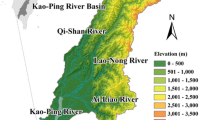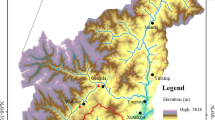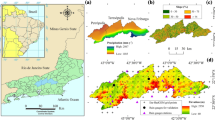Abstract
This study ascertains the disaster impacts of extreme rainfall events at the river basin scale. Several numerical models were employed, including TRIGRS for shallow landslide, Flo-2D for debris flow, SOBEK for flooding, and FVCOM for coastline disasters. The connection between numerical models was determined by the input and output data of the scenario. The worst case was selected as the extreme event, i.e. the typhoon event with the most rainfall at the end of the century (2074–2099). Climate change data, including rainfall data, the return period of rainfall events, air pressure, tide data, and sea level were generated after bias correction for the disaster assessment. A river basin with a reservoir was selected as the study area and disaster potential was separately shown for upstream and downstream areas. All disaster impacts are represented on a river basin scale. The result shows that more sediment will affect mountain ways and a large volume of sediment will enter the reservoir. The reservoir is not affected because it has sufficient capacity. The most severe flooding will occur at parts where the main river curves, which are also key areas of mitigation. Finally, the coastline area is at low risk due to the far typhoon track. This result highlights key areas where disaster prevention measures should be implemented during a severe rainfall event.








Similar content being viewed by others
References
Buma J, Dehn M (1998) A method for predicting the impact of climate change on slope stability. Environ Geol 35(2–3):190–196. doi:10.1007/s002540050305
Central geological survey (2011) Research on application of the investigation results for the upstream watershed of flood-prone area (1/3)
Chen HL, Cheng JC (2007) The discharge and sediment load of heavy rainfall events in the Tsengwen river basin, Southern Taiwan. J Geogr Sci 48:43–65. doi:10.6161/jgs.2007.48.03
Chen C, Cowles G, Beardsley RC (2004) An unstructured grid, finite-volume coastal ocean model: FVCOM user manual. Tech. Rep. 04-0601, School of Mar. Science and Technology, 1st edn. University of Mass, Dartmouth, Massachusetts, p 183
Chen C, Beardsley RC, Cowles G (2006) An unstructured grid, finite-volume coastal ocean model (FVCOM) system. Oceanography 19(1):78–89. doi:10.5670/oceanog.2006.92
Chen SC, Shih PY, Wu CH (2013) Sediment influence associated with extreme events on the channel pattern in the Chenyoulan river. J Chin Soil Water Conserv 44(4):311–323
Cheng KS, Hou JC, Wu YC, Liou JJ (2009) Assessing the impact of climate change on annual typhoon rainfall—a stochastic simulation approach. Paddy Water Environ 7:333–340. doi:10.1007/s10333-009-0183-9
Collison A, Wade S, Griffiths J, Dehn M (2000) Modelling the impact of predicted climate change on landslide frequency and magnitude in SE England. Eng Geol 55:205–218. doi:10.1016/S0013-7952(99)00121-0
Dumas P, Hallegatte S, Quintana-Segu´ı P, Martin E (2013) The influence of climate change on flood risks in France—first estimates and uncertainty analysis. Nat Hazards Earth Syst Sci 13:809–821. doi:10.5194/nhess-13-809-2013
Environmental Protection Administration (2009) Extreme events and disasters are the biggest threat to Taiwan, Typhoon Morakot, Taipei
Ho SC, Lin BS, Chang YL, Chi SY, Chien YD, Tsai MF, Fei LY (2013) Post-Typhoon Morakot Treatment Assessment on Sediment Protection and Management for Tseng-wen Reservoir Watershed. Sinotech 118: 21–30
Ho SC, Lin BS, Wu CY, Chen SC, Chien YD, Tsai MF (2015) Environment assessment system for the Tseng-Wen and Baihe reservoir watersheds in Taiwan. J Soil Water Conserv 46(3):171–180
Huo A, Li H (2013) Assessment of climate change impact on the stream-flow in a typical debris flow watershed of Jianzhuangcuan catchment in Shaanxi Province, China. Environ Earth Sci 69:1931–1938. doi:10.1007/s12665-012-2025-0
Kabiri R, Bai VR, Chan A (2015) Assessment of hydrologic impacts of climate change on the runoff trend in Klang watershed, Malaysia. Environ Earth Sci 73:27–37. doi:10.1007/s12665-014-3392-5
Iverson RM (2000) Landslide triggering by rain infiltration. Water Resour Res 36(7):1897–1910. doi:10.1029/2000WR900090
Lin GW, Chen H (2012) The impact of 2009 Typhoon Morakot on sediment discharge in central and southern rivers of Taiwan. West Pac Earth Sci 12(1):147–161
Lin LY, Chen YM, Chu JL, Liu PL, Lee HL, Huang YC (2013) Introduction to the Taiwan climate change projection and information platform project. Global Aspect 3(3), APEC research center for typhoon and society
Luna BQ, Blahut J, Camera C, Westen CV, Apuani T, Jetten V, Sterlacchini S (2014) Physically based dynamic run-out modelling for quantitative debris flow risk assessment: a case study in Tresenda, northern Italy. Environ Earth Sci 72:645–661. doi:10.1007/s12665-013-2986-7
Mahabaleshwara H, Nagabhushan HM (2014) A study on soil erosion and its impacts on floods and sedimentation. Int J Res Eng Technol 3(3):443–451. doi:10.15623/ijret.2014.0315086
Mellor GL, Yamada T (1982) Development of a turbulence closure model for geophysical fluid problem. Rev Geophys Space Phys 20:851–875. doi:10.1029/RG020i004p00851
National Science Council (2011) Climate change in Taiwan: Scientific report 2011, TCCIP office
National Science and Technology center for Disaster Reduction (2010) Disaster survey and anlysis of Morakot typhoon, National Science Council Report: NSC 98-2625-M-492-010
Nitta T, Kanae S, Oki T (2010) Change of flood risk under climate change based on discharge probability index of Japan. J Japan Soc Civ Eng 54:451–456
Piani C, Haerter JO, Coppola E (2010a) Statistical bias correction for daily precipitation in regional climate models over Europe. Theor Appl Climatol 99:187–192. doi:10.1007/s00704-009-0134-9
Piani C, Weedon GP, Best M, Gomes SM, Viterbo P, Hagemann S, Haerter JO (2010b) Statistical bias correction of global simulated daily precipitation and temperature for the application of hydrological models. J Hydrol 395:199–215. doi:10.1016/j.jhydrol.2010.10.024
Smagorinsky J (1963) General circulation experiments with the primitive equations. Part I. The basic experiment. Month Weath Rev 91:99–164. doi:10.1175/1520-0493(1963)091
Su YF, Liou JJ, Cheng CT, Kitoh A (2014) Assessment of the change of typhoon rainfall event characteristics using dynamic downscaling data under a climate change scenario. J Taiwan Agric Eng 60(4):48–60
Tachigawa Y, Takino S, Ichikawa Y, Shiba M (2009) Study on the impact of climate change on river flow regime in the Mogami and Yoshino river basins. J Japan Soc Civ Eng 53:475–480
Tsai KJ, Chen YH, Chiang JL, Chen YR, Peng TC (2014) An indicator of hydrologic Alteration (IHA) for Kaoping watershed management under extremely heavy rainfall event in Southern Taiwan. Taiwan Min Ind 66(1):28–40
Water Resource Agency (2005) Development of geomorphic and hydrologic information inquiry system for integrated basin management of major rivers in Taiwan project. Water Resource Agency, Taipei
Water Resource Agency (2006) Investigation of current status in Tsengwen River system. Water Resource Agency, Taipei
Water Resource Agency (2009) A study on the development the physiographic inundation warning model for the drainage system in the coastal low-altitude plains—an illustrative example from the south side of the north embankment of the Zengwun River creek to the north side of the south embankment of the Erren River creek (1). Water Resource Agency, Taipei
Water Resource Agency (2010) A study on the development the physiographic inundation warning model for the drainage system in the coastal low-altitude plains—an illustrative example from the south side of the north embankment of the Zengwun River creek to the north side of the south embankment of the Erren River creek (2). Water Resource Agency, Taipei
Water Resource Agency (2011) Project on Zheng-wen and Nan-hua and Wu-shan-tou reservoirs management and stable water supply in southern area. Water Resource Agency, Taipei
Water Resource Agency (2013) Assessment of hydrologic scenarios under climate change (2/2). Water Resource Agency, Taipei
Zhang P, Hu J, Shu H, Han T, Zhang Y (2015) Simulating debris flow deposition using a two-dimensional finite model and soil conservation service-curve number approach for Hanlin gully of southern Gansu (China). Environ Earth Sci 73:6417–6426. doi:10.1007/s12665-014-3865-6
Author information
Authors and Affiliations
Corresponding author
Rights and permissions
About this article
Cite this article
Wu, T., Li, HC., Wei, SP. et al. A comprehensive disaster impact assessment of extreme rainfall events under climate change: a case study in Zheng-wen river basin, Taiwan. Environ Earth Sci 75, 597 (2016). https://doi.org/10.1007/s12665-016-5370-6
Received:
Accepted:
Published:
DOI: https://doi.org/10.1007/s12665-016-5370-6




